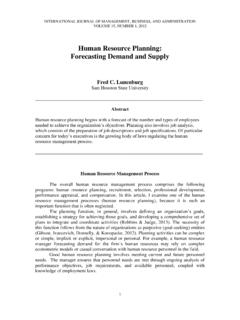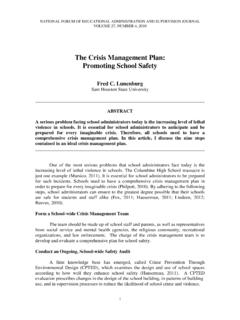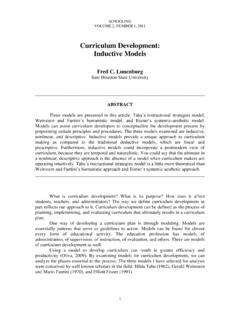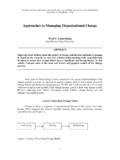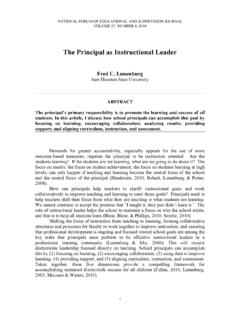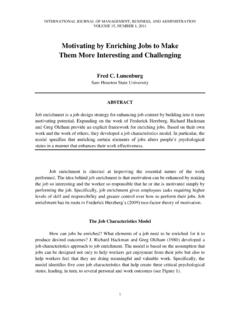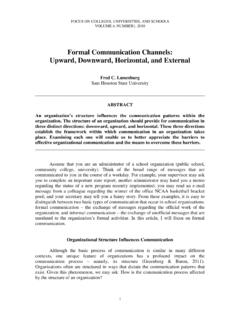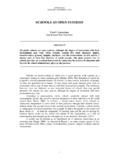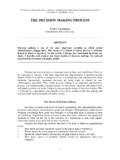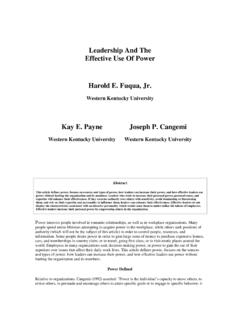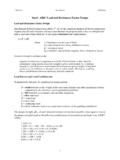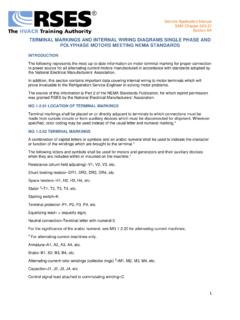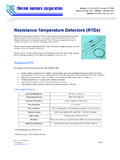Transcription of Forces for and Resistance to Organizational Change
1 NATIONAL FORUM OF EDUCATIONAL ADMINISTRATION AND SUPERVISION JOURNAL. VOLUME 27, NUMBER 4, 2010. Forces for and Resistance to Organizational Change Fred C. Lunenburg Sam Houston State University _____. ABSTRACT. Organizational Change is the movement of an organization away from its present state and toward some desired future state to increase its effectiveness. The education environment is constantly changing, and the school organization must adapt to these Forces in order to remain relevant and effective. In this article, I examine the Forces for and Resistance to Organizational Change . Lewin's force-field theory of Change serves as a useful model in understanding the Change process. _____. The role of the school leader is both intense and diverse. Paradoxically, the only constant in the school leader's ever increasing responsibilities is that of Change Change in the physical environment, Change in the curriculum, Change in faculty and staff, Change in the student body, unexpected Change , and most importantly Change that can bring about vast improvements in a school district, community college, or university.
2 The school leader must be the primary catalyst in order for the Change to be both positive and lasting (Fullan, 2010; Hargreaves, 2011; Marzano & Waters, 2010). Organizational Change is the movement of an organization away from its present state and toward some desired future state to increase its effectiveness. Why does an organization need to Change the way it performs its activities? The education environment is constantly changing, and the school organization must adapt to these Forces in order to remain relevant and effective (Blankstein, 2010; Creemers, 2011;. Smylie, 2010). Figure 1 lists the most important Forces for and Resistance to Change that confront school organizations and its leaders. 1. NATIONAL FORUM OF EDUCATIONAL ADMINISTRATION AND SUPERVISION JOURNAL. 2_____.
3 Forces for Change Resistance to Change _____. External Forces Uncertainty Marketplace Concern over personal loss Government laws and regulations Group Resistance Technology Dependence Labor markets Trust in administration Economic changes Awareness of weaknesses in the proposed Internal Forces Change Administrative processes People problems _____. Figure 1. Forces for and Resistance to Organizational Change . Forces for Change Given a choice, most school organizations prefer stability to Change . Why? Because the more predictable and routine activities are, the higher the level of efficiency that can be obtained. Thus, the status quo is preferred in many cases. However, schools are not static, but continuously Change in response to a variety of Forces coming from both inside and outside the school (Duke, 2011).
4 For school leaders, the challenge is to anticipate and direct Change processes so that school performance is improved (Szarlan, 2011). Several important factors in each of these categories (internal and external Forces ). will now be considered (Fullan, 2011; Hargreaves, 2011; Spector, 2011). External Forces The external Forces for Change originate in the school's environment. They include the marketplace, government laws and regulations, technology, labor markets, and economic changes. Marketplace. The marketplace, in recent years, has affected schools by introducing competition both from within a school district in the form of magnet schools, learning choice schools, and the like; and from outside the school district including private schools, store-front schools, and home instruction (Ludvigsen, 2011).
5 FRED C. LUNENBURG. _____3. Government laws and regulations. Government laws and regulations are a frequent impetus for Change . As a case in point, strict enforcement of Equal Employment Opportunity Commission regulations cause many school districts to examine carefully their hiring, promotion, and pay policies for women and minorities (Robinson, 2010). The No Child Left Behind Act of 2001 (Public Law 107-110) has had a significant impact on the operation of public schools throughout the country. Technology. Technological innovations have created the need for Change in schools (D'Agustino, 2011). Computers have made possible high-speed data processing and retrieval of information and have created the need for new positions. Labor markets. The fluctuation of labor markets Forces school leaders to initiate Change .
6 For instance, the education, talents, and attitudes of potential teachers play an important role in a school's effectiveness. Changes in these facets of the labor force can lead to a shortage or a surplus of qualified teachers. Economic changes. Economic changes affect schools as well. During periods of recession, inflation, or downturns in the local or national economy, the attitudes and morale of some staff members suffer, which may hinder school performance (Brimley &. Garfield, 2009). Internal Forces Pressures in the internal environment of the school district/school can also stimulate Change . The two most significant internal pressures for Change come from administrative processes and people problems. Administrative processes. Processes that act as pressures for Change include communications, decision making, leadership, and motivational strategies, to name only a few.
7 Breakdowns or problems in any of these processes can create pressures for Change . Communications may be inadequate; decisions may be of poor quality; leadership may be inappropriate for the situation; and staff motivation may be nonexistent. Such processes reflect breakdowns or problems in the school district/school and may reflect the need for Change (Gibson, Ivancevich, Donnelly, & Konopaske, 2012). People problems. Some symptoms of people problems are poor performance levels of teachers and students; high absenteeism of teachers or students; high dropout rates of students; high teacher turnover; poor school-community relations, poor management-union relations; and low levels of staff morale and job satisfaction (Bulach, Lunenburg, & Potter, 2008; Lunenburg & Ornstein, 2008).
8 A teacher's strike, numerous employee complaints, and the filing of grievances are some tangible signs of problems in the internal environment (Alexander & Alexander, 2009). These factors provide a signal to school leaders that Change is necessary. In addition, internal pressures for Change occur in response to Organizational changes that are designed to deal with pressures for Change exerted by the external environment. NATIONAL FORUM OF EDUCATIONAL ADMINISTRATION AND SUPERVISION JOURNAL. 4_____. Resistance to Change Forces for Change are a recurring feature of school life. It is also inevitable that Change will be resisted, at least to some extent by both school leaders and staff. There is a human tendency to resist Change , because it Forces people to adopt new ways of doing things.
9 In order to cope with this recurring problem, school leaders must understand why people resist Change . The most powerful impediments to Change include uncertainty, concern over personal loss, group Resistance , dependence, trust in administration, and awareness of weaknesses in the proposed Change (Fullan, 2009; Spector, 2011). Uncertainty Teachers may resist Change because they are worried about how their work and lives will be affected by the proposed Change . Even if they have some appreciable dissatisfaction with their present jobs, they have learned what their range of responsibilities are and what their administrator's reaction to their behavior will be in certain situations. Any Change creates some potential uncertainties. Concern over Personal Loss Appropriate Change should benefit the school district/school as a whole, but for some staff members, the cost of Change in terms of lost power, prestige, salary, quality of work, or other benefits will not be sufficiently offset by the rewards of Change .
10 Organization members may feel Change will diminish their decision-making authority, accessibility to information, autonomy, and the inherent characteristics of the job. Group Resistance Groups establish norms of behavior and performance that are communicated to members. This communication establishes the boundaries of expected behaviors. Failure to comply with such norms usually results in sanctions against group members by the group. If school leaders initiate changes that are viewed as threatening to the staffs'. norms, they are likely to meet with Resistance . The more cohesive the staff is, the greater their Resistance to Change will be. This may explain partially what causes wildcat strikes by teachers when school districts introduce changes without proper notification and preparation.
